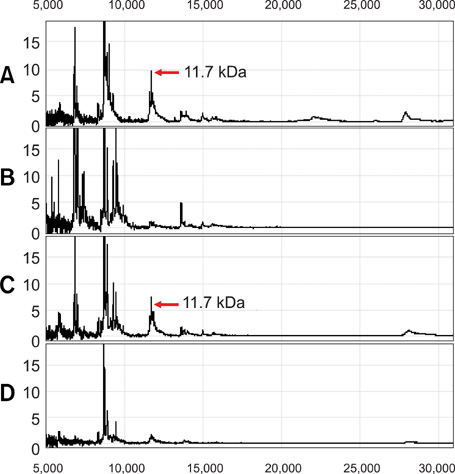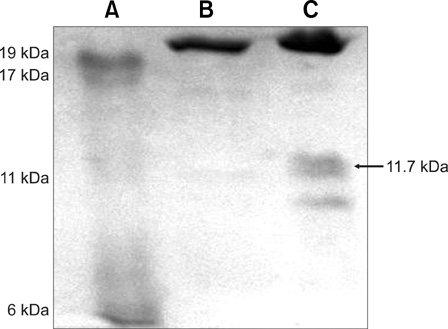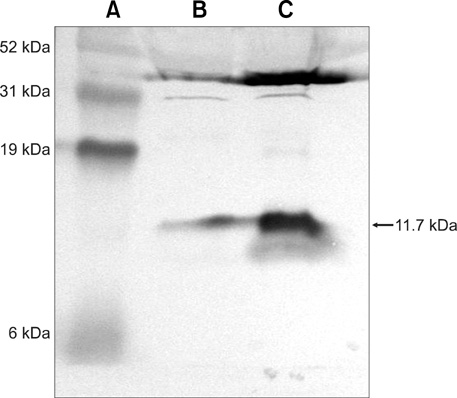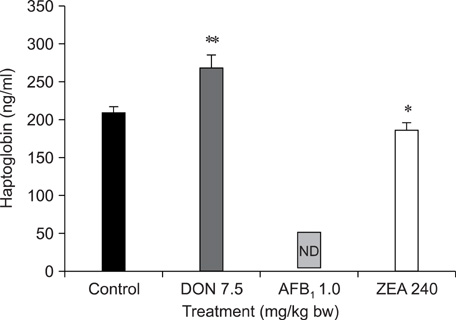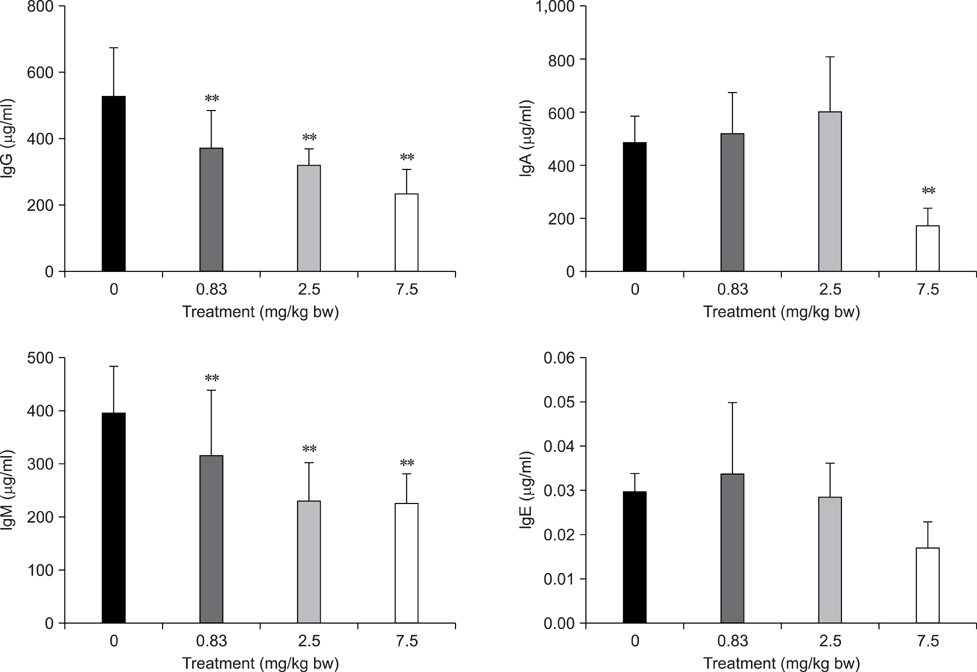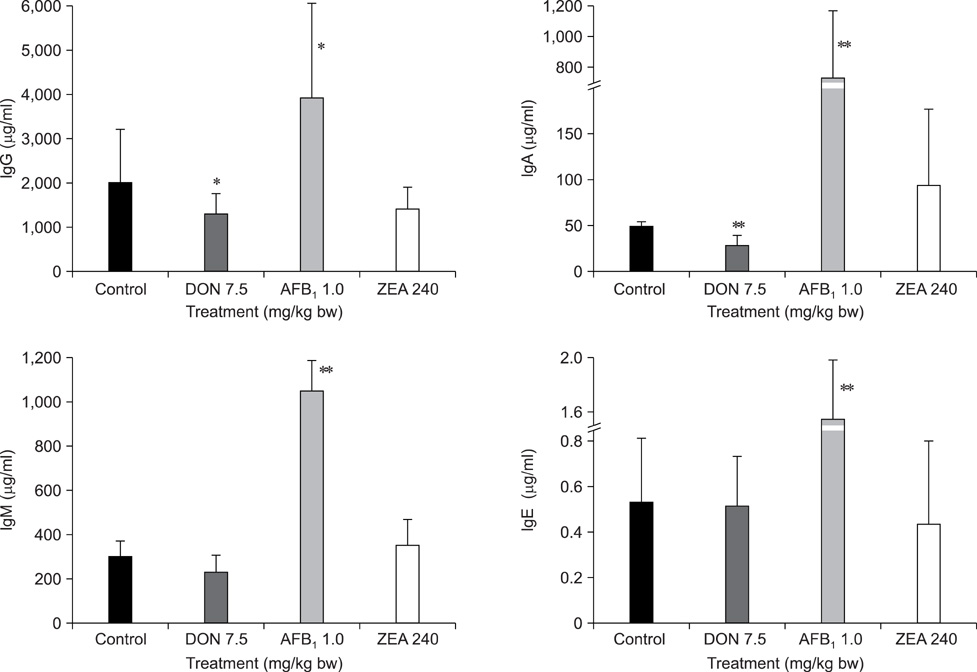J Vet Sci.
2008 Sep;9(3):257-266. 10.4142/jvs.2008.9.3.257.
Plasma haptoglobin and immunoglobulins as diagnostic indicators of deoxynivalenol intoxication
- Affiliations
-
- 1National Veterinary Research & Quarantine Service, Anyang 430-824, Korea. jeongsh@nvrqs.go.kr
- 2Environmental Toxicology and Risk Assessment, Graduate School of Public Health, Seoul National University, Seoul 110-799, Korea.
- KMID: 1718578
- DOI: http://doi.org/10.4142/jvs.2008.9.3.257
Abstract
- This study aimed to discover potential biomarkers for dioxynivalenol (DON) intoxication. B6C3F1 male mice were rally exposed to 0.83, 2.5 and 7.5 mg/kg body weight (bw) DON for 8 days and the differential protein expressions in their blood plasma were determined by SELDI - Time-of-Flight/Mass Spectrometry (TOF/MS) and the immunoglobulins (Igs) G, A, M and E in the serum were investigated. 11.7 kDa protein was significantly highly expressed according to DON administration and this protein was purified by employing a methyl ceramic HyperD F column with using optimization buffer for adsorption and desorption. The purified protein was identified as a haptoglobin precursor by peptide mapping with using LC/Q-TOF/MS and MALDI-TOF/MS and this was confirmed by western blotting and ELISA. IgG and IgM in serum were decreased in a dose-dependent manner and IgA was decreased at 7.5 mg/kg bw DON administration, but the IgE level was not changed. To compare the expressions of haptoglobin and the Igs patterns between aflatoxin B1 (AFB1), zearalenone (ZEA) and DON intoxications, rats were orally administered with AFB1 1.0, ZEA 240 and DON 7.5 mg/kg bw for 8 days. Haptoglobin was increased only at DON 7.5 mg/kg bw, while it was slightly decreased at ZEA 240 mg/kg bw and it was not detected at all at AFB1 1.0 mg/kg bw. IgG and IgA were decreased by DON, but IgG, IgA, IgM and IgE were all increased by AFB1. No changes were observed by ZEA administration. These results show that plasma haptoglobin could be a diagnostic biomarker for DON intoxication when this is combined with examining the serum Igs.
Keyword
MeSH Terms
Figure
Reference
-
1. Alsemgeest SP, Van't Klooster GA, Van Miert AS, Hulskamp-Koch CK, Gruys E. Primary bovine hepatocytes in the study of cytokine induced acute-phase protein secretion in vitro. Vet Immunol Immunopathol. 1996. 53:179–184.
Article2. Betina V. Structure-activity relationships among mycotoxins. Chem Biol Interact. 1989. 71:105–146.
Article3. Bowman BH, Kurosky A. Haptoglobin: the evolutionary product of duplication, unequal crossing over, and point mutation. Adv Hum Genet. 1982. 12:189–261.
Article4. Bruun JM, Nielsen CB, Pedersen SB, Flyvbjerg A, Richelsen B. Estrogen reduces pro-inflammatory cytokines in rodent adipose tissue: studies in vivo and in vitro. Horm Metab Res. 2003. 35:142–146.
Article5. Creppy EE. Update of survey, regulation and toxic effects of mycotoxins in Europe. Toxicol Lett. 2002. 127:19–28.
Article6. Forsell JH, Jensen R, Tai JH, Witt M, Lin WS, Pestka JJ. Comparison of acute toxicities of deoxynivalenol (vomitoxin) and 15-acetyldeoxynivalenol in the B6C3F1 mouse. Food Chem Toxicol. 1987. 25:155–162.
Article7. Forsyth DM, Yoshizawa T, Morooka N, Tuite J. Emetic and refusal activity of deoxynivalenol to swine. Appl Environ Microbiol. 1977. 34:547–552.
Article8. Goyarts T, Dänicke S. Bioavailability of the Fusarium toxin deoxynivalenol (DON) from naturally contaminated wheat for the pig. Toxicol Lett. 2006. 163:171–182.
Article9. Goyarts T, Grove N, Dänicke S. Effects of the Fusarium toxin deoxynivalenol from naturally contaminated wheat given subchronically or as one single dose on the in vivo protein synthesis of peripheral blood lymphocytes and plasma proteins in the pig. Food Chem Toxicol. 2006. 44:1953–1965.
Article10. Grange JM, Kardjito T, Beck JS, Ebeid O, Köhler W, Prokop O. Haptoglobin: an immunoregulatory role in tuberculosis? Tubercle. 1985. 66:41–47.
Article11. Gruys E, Toussaint MJM, Niewold TA, Koopmans SJ. Acute phase reaction and acute phase proteins. J Zhejiang Univ Sci B. 2005. 6:1045–1056.
Article12. Kim EJ, Jeong SH, Ku HO, Kang HG, Cho JH. Clinical and Toxico-pathological Parameters for Deoxynivalenol intoxication in B6C3F1 Mice. J Toxicol Pub Health. 2007. 23:353–362.
Article13. Kinser S, Jia Q, Li M, Laughter A, Cornwell PD, Christopher Corton J, Pestka JJ. Gene expression profiling in spleens of deoxynivalenol-exposed mice: immediate early genes as primary targets. J Toxicol Environ Health A. 2004. 67:1423–1441.
Article14. Knopman D. Cerebrospinal fluid beta-amyloid and tau proteins for the diagnosis of Alzheimer disease. Arch Neurol. 2001. 58:349–350.15. Kubena LF, Harvey RB, Huff WE, Corrier DE, Philips TD, Rottinghaus GE. Influence of ochratoxin A and T-2 toxin singly and in combination on broiler chickens. Poult Sci. 1989. 68:867–872.
Article16. Kubena LF, Huff WE, Harvey RB, Phillips TD, Rottinghaus GE. Individual and combined toxicity of deoxynivalenol and T-2 toxin in broiler chicks. Poult Sci. 1989. 68:622–626.
Article17. Langlois MR, Delanghe JR. Biological and clinical significance of haptoglobin polymorphism in humans. Clin Chem. 1996. 42:1589–1600.
Article18. Lou K, Shanbrom E. Immunodiffusion techniques in clinical medicine. II. Radial immunodiffusion. JAMA. 1967. 200:323.
Article19. Lyoumi S, Tamion F, Petit J, Déchelotte P, Dauguet C, Scotté M, Hiron M, Leplingard A, Salier JP, Daveau M, Lebreton JP. Induction and modulation of acute-phase response by protein malnutrition in rats: comparative effect of systemic and localized inflammation on interleukin-6 and acute-phase protein synthesis. J Nutr. 1998. 128:166–174.
Article20. Meky FA, Turner PC, Ashcroft AE, Miller JD, Qiao YL, Roth MJ, Wild CP. Development of a urinary biomarker of human exposure to deoxynivalenol. Food Chem Toxicol. 2003. 41:265–273.
Article21. Oh SK, Very DL, Walker J, Raam S, Ju ST. An analogy between fetal haptoglobin and a potent immunosuppressant in cancer. Cancer Res. 1987. 47:5120–5126.22. Osweiler GD. Mycotoxins. Contemporary issues of food animal health and productivity. Vet Clin North Am Food Anim Pract. 2000. 16:511–530.
Article23. Osweiler GD, Carr TF, Sanderson TP, Carson TL, Kinker JA. Water Deprivation-sodium ion toxicosis in cattle. J Vet Diagn Invest. 1995. 7:583–585.
Article24. Pestka JJ, Smolinski AT. Deoxynivalenol: toxicology and potential effects on humans. J Toxicol Environ Health B Crit Rev. 2005. 8:39–69.
Article25. Piva M, Horowitz GM, Sharpe-Timms KL. Interleukin-6 differentially stimulates haptoglobin production by peritoneal and endometriotic cells in vitro: a model for endometrial-peritoneal interaction in endometriosis. J Clin Endocrinol Metab. 2001. 86:2553–2561.
Article26. Robbana-Barnat S, Lafarge-Frayssinet C, Cohen H, Neish GA, Frayssinet C. Immunosuppressive properties of deoxynivalenol. Toxicology. 1988. 48:155–166.
Article27. Rotter BA, Prelusky DB, Pestka JJ. Toxicology of deoxynivalenol (vomitoxin). Toxicol Environ Health. 1996. 48:1–34.28. Schrader M, Schulz-Knappe P. Peptidomics technologies for human body fluids. Trends Biotechnol. 2001. 19:S55–S60.
Article29. Scott PM. Chelkowski J, editor. Possibilities of reduction or elimination of mycotoxins present in cereal grains. Cereal Grain: Mycotoxins, Fungi and Quality in Drying and Storage. 1991. Amsterdam: Elsevier;529–572.30. Thompson WL, Wannemacher RW Jr. Structure-function relationships of 12,13-epoxytrichothecene mycotoxins in cell culture: comparison to whole animal lethality. Toxicon. 1986. 24:985–994.
Article31. Tryphonas H, O'Grady L, Arnold DL, McGuire PF, Karpinski K, Vesonder RF. Effect of deoxynivalenol (vomitoxin) on the humoral immunity of mice. Toxicol Lett. 1984. 23:17–24.
Article32. Verma M. Biomarkers for risk assessment in molecular epidemiology of cancer. Technol Cancer Res Treat. 2004. 3:505–514.
Article33. Warner RL, Brooks K, Pestka JJ. In vitro effects of vomitoxin (deoxynivalenol) on T-cell interleukin production and IgA secretion. Food Chem Toxicol. 1994. 32:617–625.
Article34. World Health Organization (WHO). Environ Health Criteria. No. 105. Selected Mycotoxins: Ochratoxin, Tricothecenes, Ergot. 1990. Geneva: WHO.35. World Health Organization (WHO). Environ Health Criteria. No. 222. Biomarkers in Risk Assessment: Validity and Validation. 2001. Geneva: WHO.36. Widestrand J, Lundh T, Pettersson H, Lindberg JE. A rapid and sensitive cytotoxicity screening assay for trichothecenes in cereal samples. Food Chem Toxicol. 2003. 41:1307–1313.
Article37. Ye B, Cramer DW, Skates SJ, Gygi SP, Pratomo V, Fu L, Horick NK, Licklider LJ, Schorge JO, Berkowitz RS, Mok SC. Haptoglobin-α subunit as potential serum biomarker in ovarian cancer: identification and characterization using proteomic profiling and mass spectrometry. Clin Cancer Res. 2003. 9:2904–2911.38. Zhang L, Yu W, He T, Yu J, Caffrey RE, Dalmasso EA, Fu S, Pham T, Mei J, Ho JJ, Zhang W, Lopez P, Ho DD. Contribution of human alpha-defensin 1, 2, and 3 to the anti-HIV-1 activity of CD8 antiviral factor. Science. 2002. 298:995–1000.
Article
- Full Text Links
- Actions
-
Cited
- CITED
-
- Close
- Share
- Similar articles
-
- Proteomic Analysis of Haptoglobin and Amyloid A Protein Levels in Patients with Vivax Malaria
- Long-Lived Plasma Cell
- Clinical Significance of Immediate Determination of Plasma Cholinesterase Level in Patients Presenting with Organophosphate Ingestion at the Time of Hospitalization
- Macroamylasemia in a 4-year-old girl with abdominal pain
- Immunoglobulins for Prophylaxis or Treatment of Infectious Diseases


